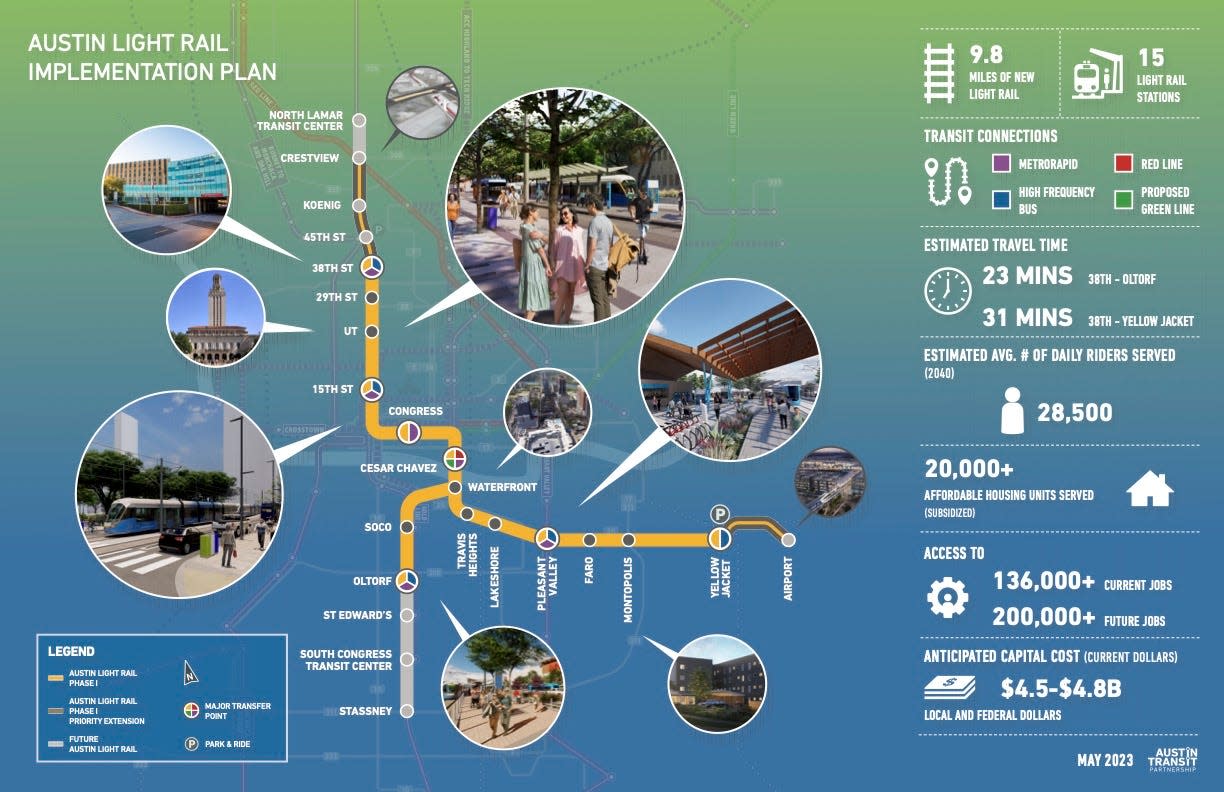Austin's Project Connect light rail details unveiled. What we know about the $7.1B project

Plans for the first phase of Project Connect are now public and include 9.8 miles of new light rail line in Austin stretching from 38th Street through downtown.
The Austin Transit Partnership, the group tasked to implement Project Connect, unveiled the project's implementation plan Tuesday. It is the first time the public is getting a detailed look at the new rail line system.
Austin voters approved a tax rate increase to help finance Project Connect in 2020. The cost was estimated to be nearly $7.1 billion, but inflation has led those estimates to balloon past $11 billion since the election.
Initial plans had included building two light rail lines, a downtown tunnel with an underground shopping center and multiple rapid bus routes. In addition, Project Connect would provide housing funds, equitable development planning and more city park-and-ride options.
But plans have been watered down due to concerns about rising costs. According to the plans presented Tuesday, the project still provides a public transit option, but it will no longer include a downtown tunnel or the underground shopping center.
The reduced plans would help draw the costs back to the originally estimated amount, planners say.
This is all despite a potential slowdown caused by the passage of House Bill 3899 by Rep. Ellen Troxclair, R-Lakeway, which could derail the project by targeting the financing necessary for its completion.
The project also faces scrutiny from Texas Attorney General Ken Paxton, whose latest opinion states the financing model for Project Connect is likely illegal under state law.
In spite of the uncertainty, here is what we know about the project as it currently stands:
What does phase 1 include?
In March, the Austin Transit Partnership sought community input on five potential options for a core light rail system through downtown that included partially underground lines, a complete street level option and partial elevation.
Plans revealed Tuesday show the rail line will include an on-street train starting at 38th Street, traveling down Guadalupe Street and turning on Third Street before crossing Lady Bird Lake at Trinity Street. Once the train crosses the lake, the lines will split. One line will continue down South Congress Avenue to Oltorf Street, and another will go east on Riverside Drive to Yellow Jacket Lane, stopping short of Austin-Bergstrom International Airport. There will be 15 stations along the route.
Greg Canally, executive director for the Austin Transit Partnership, said there are opportunities for extensions north to Crestview and east to the airport, pending additional funding.
More: Kirk Watson cedes legislative fight over Project Connect, prepares for November election
How much is it going to cost?
The construction cost is expected to range between $4.5 billion and $4.8 billion, made up of a mix of local and federal dollars.
Austin voters in 2020 approved an 8.75 cent increase per $100 in taxable value to city property taxes to help pay for the project, but more than half of the project’s cost is expected to be funded by federal grants.
Canally said it could be several years before construction begins, and time can affect costs.
That does not include annual operations and maintenance costs, which range between $25 million and $50 million. The tax rate increase approved by voters is expected to pay for operations and maintenance over time. As the funding for construction decreases throughout the buildout that is replaced by an increase in operating costs, officials said.
More: Austin's Project Connect attracts opposition in Texas Legislature. But were voters misled?
What are the benefits of this option?
Transit officials say the project will offer better connectivity throughout the city and will help make investments in access to affordable housing and workforce opportunities. It is also expected to improve commute times. The on-street option provides easy access because there are no stairs.
Commute times are expected to range between 20 and 30 minutes depending on how far south or east the rider is going. The access south on Congress and east on Riverside Drive also provides access to more than 20,000 affordable housing units and more than 136,000 jobs.
Canally said the project has the potential to bring more jobs and homes along the route, adding that the project does keep in mind anti-displacement goals.
More: Austin dedicated land to deeply affordable housing, but the site's history raises concerns
Lindsay Wood, lead engineer for the partnership, said what is also important about this core system is its opportunities for multimodal connection, including biking, walking and using the bus system.
“One of things we have heard consistently is about how important overall system connectivity is for people,” Wood said. “Because one piece rarely can serve all a person’s needs. ... We are looking at maximizing the overall reach the light rail is providing by way of intermodal connections along the alignment.”
What about that House bill?
On Monday, House Bill 3899 passed the Senate 29-1, which requires Austin to get voter approval before issuing debt to build the light rail.
More: Austin is getting pummeled by the Texas Legislature. The beating could continue this week.
Canally said the group was committed to fulfilling the will of the voters to implement the light rail, and believed that as a local government corporation, it has the authority to issue bonds and notes and cities have the authority to transfer funds to it.
“ATP has always recognized there are many steps ahead in our financing process, and we will follow state law and take this opinion into consideration as we advance our financing,” he said.
This article originally appeared on Austin American-Statesman: Austin's Project Connect light rail plan unveiled: What we know

